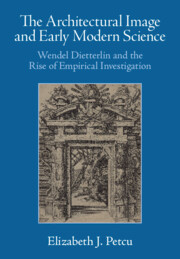 The Architectural Image and Early Modern Science
The Architectural Image and Early Modern Science Published online by Cambridge University Press: 29 November 2024
Dietterlin and other Renaissance artists supported an empirical approach to architectural image-making, one that emerged in treatises like Dietterlin’s Architectura. Such treatises became sites of conflict between rationalist and empirical mathematical traditions, with Dietterlin’s mixed arithmetic and geometrical design procedures marking a pivotal turn toward empiricism. The development of prints in architectural texts – from geometrical illustrations in masonic incunables to Dürer’s 1525 Lesson on Measurement and archaeological renderings by Sebastiano Serlio, Philibert De L’Orme, and Hans Blum – shows how Dietterlin and his contemporaries increasingly rejected received knowledge in favor of the empirical epistemology also practiced by period artists and natural philosophers. As architectural treatises shifted from rationalist to empirical approaches to architectural design, they aligned architecture with the empirical culture of Renaissance image-making exemplified in Dietterlin’s Architectura.
To save this book to your Kindle, first ensure [email protected] is added to your Approved Personal Document E-mail List under your Personal Document Settings on the Manage Your Content and Devices page of your Amazon account. Then enter the ‘name’ part of your Kindle email address below. Find out more about saving to your Kindle.
Note you can select to save to either the @free.kindle.com or @kindle.com variations. ‘@free.kindle.com’ emails are free but can only be saved to your device when it is connected to wi-fi. ‘@kindle.com’ emails can be delivered even when you are not connected to wi-fi, but note that service fees apply.
Find out more about the Kindle Personal Document Service.
To save content items to your account, please confirm that you agree to abide by our usage policies. If this is the first time you use this feature, you will be asked to authorise Cambridge Core to connect with your account. Find out more about saving content to Dropbox.
To save content items to your account, please confirm that you agree to abide by our usage policies. If this is the first time you use this feature, you will be asked to authorise Cambridge Core to connect with your account. Find out more about saving content to Google Drive.